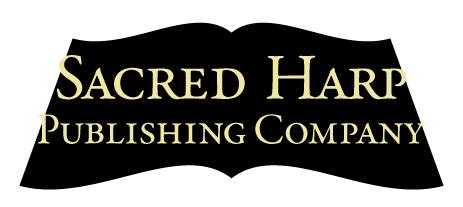Editor’s Note: In this essay, “Queen of The Sacred Harp,” Ruth Denson Edwards shares memories of her musical childhood home. Just about every day somewhere in the world Sacred Harp singers find joy and spiritual fulfillment singing songs written by the Denson family members who gathered around a big log fire to sing in The Sacred Harp at night. Edwards describes how these gatherings formed the apex of a rich musical environment that also included folk songs, string music, and quartet singing. Oh, to have heard T. J., Amanda, S. M., and Sidney Denson, all outstanding singers and composers, singing “Call John,” the confounding and humorous song that appeared for a time in the rudiments of Original Sacred Harp! In her reminiscence, Edwards also describes the effort of hosting an annual singing and the texture of a life without radio, television, or much in the way of reading material.
Ruth Denson Edwards’s reflection was first published in the February 1965 issue of the Harpeth Valley Sacred Harp News, vol. 1, no. 8, where its editor Priestley Miller, wrote:
We thank Mrs. Edwards for her “I Remember” in this issue. It will bring vicarious nostalgia to most of us as we envisage those wonderful times the Denson family had in the memorable occasions in their home. Mrs. Edwards carries on a tremendous amount of Sacred Harp work, and is an unquestioned authority in the field.
Thanks to Tim Reynolds, current editor of the Harpeth Valley Sacred Harp News, for permission to include “I Remember” in this issue of the Sacred Harp Publishing Company Newsletter.
No person has more pleasant childhood memories than I, for no one ever had a happier childhood.
My parents, the late Thomas J. Denson and the late Amanda Burdette Denson, owned a farm in Winston County, near Helicon, Alabama, and there they reared their family.
At that time our family consisted of my older brother, Paine, my foster brother, Pansy Mitchell (who was the orphan son of my mother’s sister), my older sisters, Annie and Maggie, my younger brother, Howard, and me.
I like to remember the family, sitting in a semi-circle before a big log fire at night, singing in the Sacred Harp. Pansy sang bass; mother, alto; Paine and Annie treble; Dad, Maggie, Edward, and I sang tenor.
During the singing hour, Paine popped corn and at recess we would enjoy buttered salted popcorn.
Some nights, Dad would lead off on folk songs, and the family group would join in and harmonize. (I am sure that I did not help very much, but I was “there” and I “sang.”) Some of the folk songs were: “I’m Going from the Cotton Fields,” “There’s One More River to Cross,” “Oh, Sister Mary, Lean on the Lord’s Side,” “Hump-Backed Male,” “Noah’s Ark,” and others.
On other nights, when Uncle Seab and Aunt Sidney were visiting us, we would have a concert of string music. Uncle Seab would play the fiddle; Dad would beat the straws and sing; Paine and Maggie would pick their banjos; Annie would pluck her harp; Pansy blew his harmonica; and mother, Aunt Sidney, Howard, and I sang.
Uncle Seab and Aunt Sidney’s visits were rays of sunshine in my life. They and my parents had such good times singing quartets: “Kay-Did,” “Rain on the Roof,” “The Laughing Chorus,” “Tis Better to Whistle than Whine,” “Call John,” and others. Radio and television made their advent about fifty years too late. They really missed a treat.
One of my most vivid memories is of the Fourth of July singing at Liberty Church [in Helicon]. How busy everybody was! Dad would hire an extra cook, or two, to help with the preparations. They cooked all day on July 3—cakes, pies, roast beef, chicken dressing, dumplings, fried chicken, and every good food imaginable. (My birthday comes on the 3rd day of July and Mag’s comes on July 4. She would taunt me by saying, “Oh yes, they cook the good food on your birthday and eat it on mine.” That made me very unhappy for it was true.)
Soon after lunch, on July 3, visiting singers began to arrive at our house. They came and came, and my parents gave all a hearty welcome. One night, forty people spent the night with us.
On the morrow, we all went to the singing. The Thomas J. Denson children sat in the class and sang all day. That was his iron-clad rule. At recess, everyone enjoyed pink lemonade, and at noon, we all feasted on the delicious food that the ladies had prepared.

Ruth Denson Edwards with her nephew and neice at the monument to The Sacred Harp at the Winston County Courthouse in a photograph captioned, “Aunt Ruthy Jimmy and Amanda in Double Springs, July 1968.”
Collection of the Sacred Harp Museum.
(I could name many more events that are outstanding in my memory, but space will not permit.)
At the time that I am describing, there were no recreation centers, no radios, televisions, picture shows, etc. as we have today. There were few books available. The Atlanta Constitution (a weekly) was our only newspaper and we received a few monthly magazines.
Therefore, our wise parents provided a musical environment for us children—“A home where music was the theme.”
Our group participation strengthened the family ties, supplied our wants and needs, and enabled us to live rich, full, and happy lives.
I am proud of my musical heritage and am glad to say that Sacred Harp music has always been my joy and inspiration and my love for it increases as the years pass.
I am truly thankful for my wealth of happy childhood memories.


